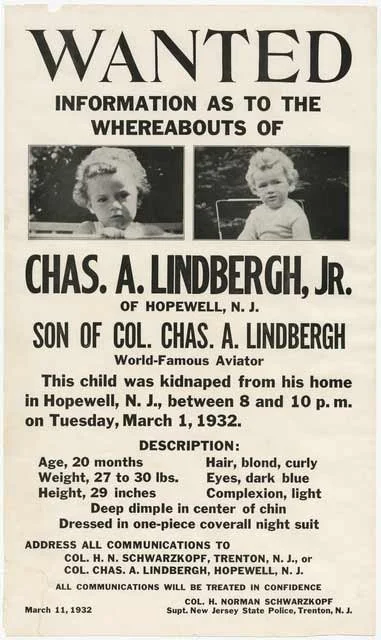The Lindbergh Baby Kidnapping: America's Most Sensational Trial
In 1932, America was electrified by the kidnapping of renowned aviator Charles Lindbergh’s 20-month-old son. Though a suspect was ultimately convicted and executed, his consistent claims of innocence and the abundance of circumstantial evidence could not withstand the national pressure of the “media circus” trial. Conspiracies abound to this day over the true identity of the culprit and whether he acted alone.
Charles Augustus Lindbergh Jr. was born on June 22nd, 1930, to 24-year-old Anne Lindbergh and 30-year-old Colonel Charles Lindbergh. The baby instantly became the subject of media adoration due to his father’s status as an American hero, according to his Biography.
On the night of March 1st, while the Lindbergh parents and household staff were elsewhere in the New Jersey house, the Lindbergh baby was kidnapped from his crib and taken down from the second-story room by ladder, narrates Britannica. Around 10PM, Charlie Jr.’s nurse discovered the scene. The open window and ransom note spelled out the crime.
“Dear Sir,” it read,
“Have 50,000$ redy 25000$ in 20$ bills 15000$ in 10$ bills and 10000$ in 5$ bills. After 2-4 days will inform you were to deliver the Mony.
We warn you for making anyding public or for notify the Polise the child is in gut care.
Indication for all letters are singnature and 3 holds.”
The police arrived en masse the following day, as did swarms of journalists, fans, and supportive volunteers, with the unfortunate side effect of trampling and obliterating potential physical evidence. Only the broken ladder outside the window was left. Investigation intensified to the point of the FBI’s involvement, and Lindbergh Sr. even “accept[ed] help from associates with connections to organized crime,” according to Biography.
Varyingly reliable tips flooded in, as did two further ransom notes, which raised the price to $70,000. On March 8th, retired teacher John F. Condon placed a newspaper ad offering his service as a go-between for communication between the Lindberghs and kidnappers, which was accepted after an extra $1000 promise. Britannica reports that a week of furtive negotiation followed, with Condon posting in news columns under the pseudonym “Jafsie” and the kidnappers rejoining with notes hidden through New York City. The ransomers provided Charlie Jr.’s sleeping suit “as proof of identity,” and on April 2nd, their demanded date for the money transfer arrived.
Condon took the lead, encountering a man he called “John” at St. Raymond’s Cemetery in the Bronx. Lindbergh Sr. waited in a car outside. Condon negotiated “John” back down to $50,000, mostly transferred in gold certificates, and was told the toddler was waiting on a boat called the Nelly near Martha’s Vineyard, Massachusetts. This boat could not be found, leaving “John’s” deal a dead end.
The worst news imaginable came for the Lindberghs on May 12th. Charlie Jr.’s body was found decomposed, burnt, and dismembered by a highway only a few miles from the Lindbergh home. The Minnesota Historical Society states that he had likely died the day of his abduction ten weeks before, meaning the entire chain of ransom demands had been for nothing.
Though tips still came in from followers of the case, and over 200 people made unprovable confessions, it seemed the hunt for the killers had ended. The Federal Kidnapping Law, also known as the Lindbergh Law, was signed after the public’s protests, making “kidnapping across state lines a federal crime and stipulat[ing] that such an offense could be punished by death.”
Then the situation changed, almost by pure chance. One of the ransomed gold certificates turned up in 1934, traced to a German immigrant, Bruno Richard Hauptmann. Police rejected his claim that he had inherited the valuable note, and after more of the notes with serial numbers matching the ransomed set were found in Hauptmann’s garage, along with Condon’s phone number, Hauptmann was charged. The media frenzy had been set in motion.
On the stand, Condon identified Hauptmann as the “John” he’d met at the graveyard—yet when shown Hauptmann earlier in a police lineup before charges were brought, he hadn’t mentioned this. Forensic evidence claimed a piece of the broken ladder matched a missing floor beam in Hauptmann’s attic, and that Hauptmann’s handwriting matched the ransom notes. Anne Lindbergh presented testimony so emotional that the defense neglected to cross-examine her.
Yet under the eyes of 700 reporters and the country’s rapt attention, Hauptmann insisted on his innocence throughout the six-week trial. Britannica reports that he claimed the police had beaten him, and that he’d been forced to produce the matching penmanship. His immigrant status and the celebrity of his accusers did him no favors in the eyes of the press and the jury. Perhaps the sentencing was inevitable: Hauptmann received the death penalty under the Lindbergh Law. His appeals went as far as the Supreme Court, but Hauptmann was executed in Trenton’s state prison by electric chair on April 3rd, 1936. He never admitted guilt.
Fascination with the true crime genre itself may have largely originated from the Lindbergh case. The story had everything: an innocent child victim from a famous family, suspicious circumstances leading up to indictment, questions of collaboration which have still gone unsolved. The media’s attitude is much the same nearly a century later. Even if you’ve never dipped a toe into true crime, the odds are good that you’ve heard the name of the Lindbergh baby. In 1932, there wasn’t an American who hadn’t.






